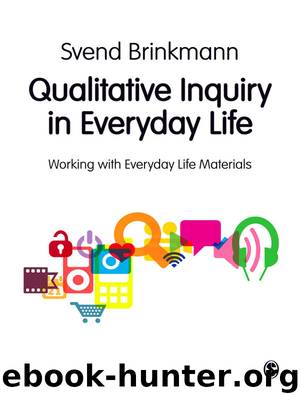Qualitative Inquiry in Everyday Life by Svend Brinkmann

Author:Svend Brinkmann [Brinkmann, Svend]
Language: eng
Format: epub
Tags: Social Science, Research, Reference
ISBN: 9781446267974
Google: QSQ_J6ZiSDIC
Barnesnoble:
Goodreads: 16607636
Publisher: SAGE
Published: 2012-07-23T00:00:00+00:00
Interpreting a life
My psychologically informed interpretation of Thomasâs life, as he articulates it in our conversation, is one of a young man in search of a worthwhile direction in life, who came across a system of symbolic resources that afforded a certain kind of self-interpretation, with a community and a number of collective social practices attached. Anne Sophieâs charismatic personality and the appealing metaphysics of Tigerâs Nest made possible a life that was at once exciting and quite well-ordered. What many of us are looking for today, I conjecture, are symbolic resources that enable us to distinguish between more and less important moments in our lives. Symbolic resources are cultural elements (like pictures, books and films) that are part of symbolic systems. Traditionally, these have been handed down from one generation to the next, particularly as part of religious traditions and practices (e.g. as crystallised in the Bible), but in todayâs post- traditional social reality, people must to some extent act as bricoleurs and construct their own identity on the basis of the resources they can find and put together. Even if they, like Thomas, experience things as happening according to a plan that they did not design for themselves.
In a well-known analysis, MacIntyre (1985) has described this situation specifically with regard to morality, which he sees as collapsing into emotivism. MacIntyre depicted an emotivist self that can only evaluate life possibilities on the basis of feelings. In some ways, I interpret Thomasâs self-descriptions as emotivist, since his choices, on the face of it, are guided explicitly (and solely) by what he feels is right for him. On this interpretation, the solidity of his conduct rests only on the permanence of his feelings. His life has woven together themes from religion, spirituality, and also psychology. In one way, Thomas has resisted the disenchanting âeverywhereness of psychologyâ (Jarzombek, 2000) by making use of spirituality and the transcendent in leading his life. Yet, in another way, the spirituality of Tigerâs Nest â if stripped of its metaphysics â comes very close to the psychologies of self-realisation and human potential movements as found, for example, at the Esalen Institute in California (where the idea of being âin processâ is also emphasised).
Nevertheless, my secularist and psychological interpretation is, of course, quite at odds with his own. According to Thomas, he has simply come home. There is something he is meant to do in this life, and his assignment became obvious to him upon first meeting the teacher and later tantric partner, Anne Sophie. Our different interpretations converge, however, on the issue that the way he lives his life now answers to a need for something. But while Thomas will invoke the transcendent in order to explain this need, I have resorted to psychological explanations about a need for meaning and community. Who has the best account? It seems impossible to say, since we do not look at life from the same set of premises. What is frustrating to me is that ten years ago, we seemed to share such premises, perspectives and vocabularies.
Download
This site does not store any files on its server. We only index and link to content provided by other sites. Please contact the content providers to delete copyright contents if any and email us, we'll remove relevant links or contents immediately.
Cecilia; Or, Memoirs of an Heiress — Volume 1 by Fanny Burney(32495)
Cecilia; Or, Memoirs of an Heiress — Volume 2 by Fanny Burney(31909)
Cecilia; Or, Memoirs of an Heiress — Volume 3 by Fanny Burney(31887)
The Great Music City by Andrea Baker(31755)
We're Going to Need More Wine by Gabrielle Union(19001)
All the Missing Girls by Megan Miranda(15766)
Pimp by Iceberg Slim(14433)
Bombshells: Glamour Girls of a Lifetime by Sullivan Steve(14020)
For the Love of Europe by Rick Steves(13507)
Talking to Strangers by Malcolm Gladwell(13284)
Norse Mythology by Gaiman Neil(13272)
Fifty Shades Freed by E L James(13185)
Mindhunter: Inside the FBI's Elite Serial Crime Unit by John E. Douglas & Mark Olshaker(9259)
Crazy Rich Asians by Kevin Kwan(9216)
The Lost Art of Listening by Michael P. Nichols(7452)
Enlightenment Now: The Case for Reason, Science, Humanism, and Progress by Steven Pinker(7271)
The Four Agreements by Don Miguel Ruiz(6696)
Bad Blood by John Carreyrou(6581)
Weapons of Math Destruction by Cathy O'Neil(6206)
